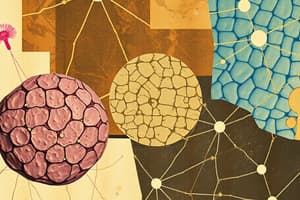Podcast
Questions and Answers
Which cell type is found in the inner cellular layer of the perichondrium and is responsible for forming cartilage?
Which cell type is found in the inner cellular layer of the perichondrium and is responsible for forming cartilage?
- Chondrogenic cell
- Chondroblast (correct)
- Chondrocyte
- None of the above
What is the primary origin of chondrocytes?
What is the primary origin of chondrocytes?
- Chondrogenic cells
- Mesenchymal stem cells
- Epithelial cells
- Chondroblasts (correct)
Which of the following characteristics describes chondrocytes?
Which of the following characteristics describes chondrocytes?
- Flat cell shape with a pale oval nucleus
- Oval cell shape with a dark central round nucleus (correct)
- Rich in ribosomes and more electron dense
- Flat morphology and dark basophilic cytoplasm
Which statement accurately reflects the morphology of a chondrogenic cell?
Which statement accurately reflects the morphology of a chondrogenic cell?
What is the function of chondroblasts in the perichondrium?
What is the function of chondroblasts in the perichondrium?
What is primarily produced by chondroblasts during the formation process?
What is primarily produced by chondroblasts during the formation process?
Which of the following best describes the role of chondroblasts?
Which of the following best describes the role of chondroblasts?
What type of collagen do chondroblasts form during cartilage development?
What type of collagen do chondroblasts form during cartilage development?
Which of the following statements about chondroblasts is NOT true?
Which of the following statements about chondroblasts is NOT true?
During which process do chondroblasts contribute to the formation of collagen fibers?
During which process do chondroblasts contribute to the formation of collagen fibers?
What is a characteristic function of matrix formation in growth?
What is a characteristic function of matrix formation in growth?
Which statement best describes interstitial growth?
Which statement best describes interstitial growth?
What is the role of chondrocytes in the context of matrix?
What is the role of chondrocytes in the context of matrix?
How does the matrix influence chondrocytes during growth?
How does the matrix influence chondrocytes during growth?
Which of the following accurately describes the process of transformation in chondrocytes?
Which of the following accurately describes the process of transformation in chondrocytes?
Which of the following is a characteristic of yellow elastic cartilage?
Which of the following is a characteristic of yellow elastic cartilage?
Which structure does NOT contain Type II collagen fibers?
Which structure does NOT contain Type II collagen fibers?
Which joint primarily allows for a limited range of movement, aiding in shock absorption and stability in the pelvis?
Which joint primarily allows for a limited range of movement, aiding in shock absorption and stability in the pelvis?
Where can yellow elastic cartilage be found?
Where can yellow elastic cartilage be found?
Which of the following structures is specifically designed for allowing rotation and significant movement?
Which of the following structures is specifically designed for allowing rotation and significant movement?
What distinguishes white fibrocartilage from other cartilage types?
What distinguishes white fibrocartilage from other cartilage types?
Which joint is located between adjacent vertebrae and serves as a crucial component of the spinal column?
Which joint is located between adjacent vertebrae and serves as a crucial component of the spinal column?
Which of the following statements about the structure of yellow elastic cartilage is false?
Which of the following statements about the structure of yellow elastic cartilage is false?
Which of the following joints is a cartilaginous joint that primarily allows for slight movement?
Which of the following joints is a cartilaginous joint that primarily allows for slight movement?
Which structure helps to cushion the joints between vertebrae and provides elasticity to the spinal column?
Which structure helps to cushion the joints between vertebrae and provides elasticity to the spinal column?
Flashcards are hidden until you start studying
Study Notes
Cartilage Cells
-
Chondrogenic Cells
- Originate from undifferentiated mesenchymal cells (UMCs)
- Found in the inner cellular layer of the perichondrium
- Differentiate into chondroblasts
-
Chondroblasts
- Originate from UMCs or chondrogenic cells
- Found in the inner cellular layer of the perichondrium
- Function:
- Form cartilage
- Form type II collagen fibers
- Form matrix
- Transform into chondrocytes when surrounded by matrix
-
Chondrocytes
- Originate from chondroblasts
- Found throughout cartilage, either singly or in groups
- Function:
- Continuously form matrix
- Responsible for interstitial growth
- Produce type II collagen fibers in the matrix
Cartilage Types
-
Hyaline Cartilage
- Flexible type of cartilage
- Appears yellow in fresh sections
- Structure: Similar to hyaline cartilage with the addition of elastic fibers in the matrix.
- Sites:
- Costal cartilage
- Articular cartilage
- Trachea and bronchi
-
Elastic Cartilage
- Flexible type of cartilage
- Structure: Same as hyaline cartilage but with more elastic fibers in the matrix
- Sites:
- Ear pinna
- External auditory meatus
- Eustachian tube
- Epiglottis
-
Fibrocartilage
- Rigid type of cartilage
- Intermediate between cartilage and white fibrous connective tissue
- Structure:
- Lacks a perichondrium
- Matrix contains collagen type I with rows of chondrocytes in between
- Sites:
- Symphysis pubis
- Intervertebral disc
- Mandibular joint
Studying That Suits You
Use AI to generate personalized quizzes and flashcards to suit your learning preferences.




